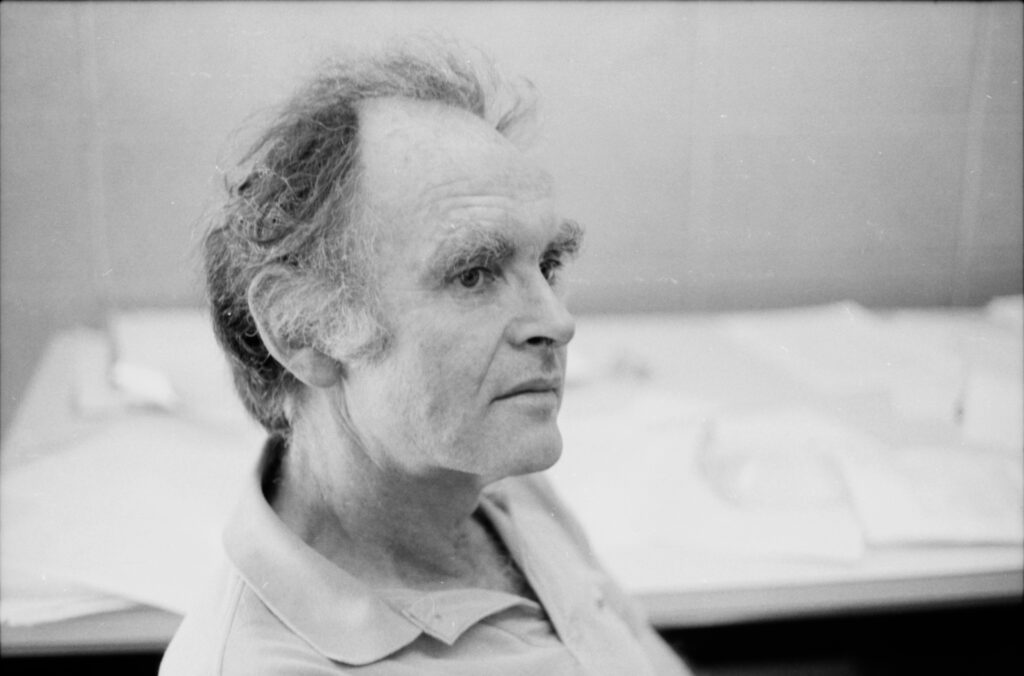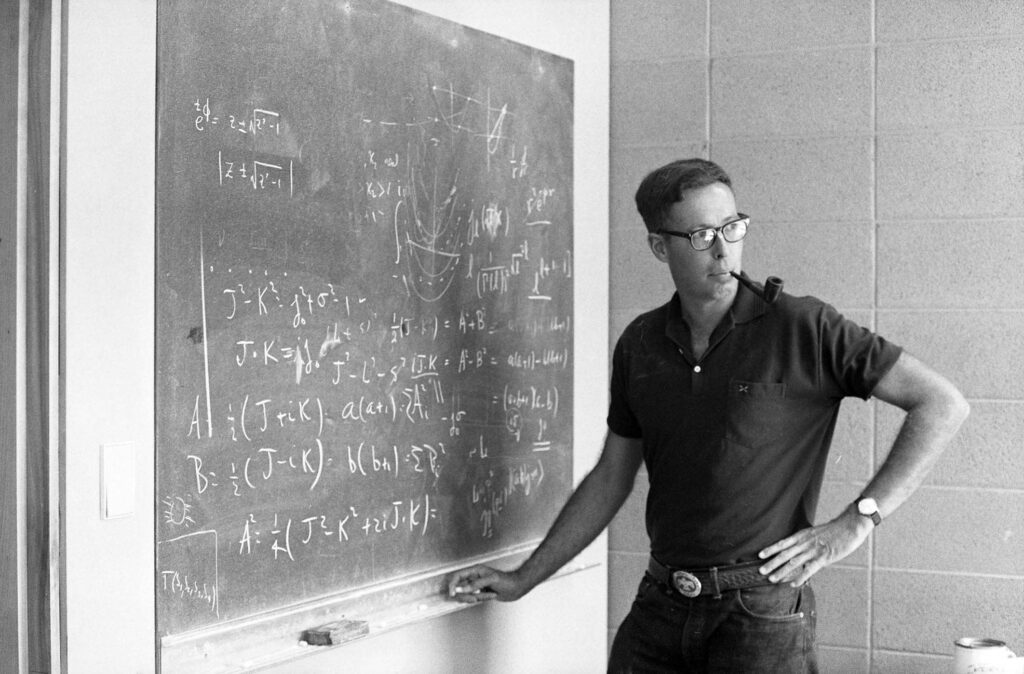Letter from the President, 1976-1979 and 1988-1989
First things first: We can all be discretely proud, through our efforts to make it possible, of the scientific work that took place at the Center. I couldn’t begin here to summarize the real work that took place while I partly watched from my administrator’s perch, but just skimming over the names of the participants and the workshops I am once again impressed at how consistently the work done at Aspen was at the front of the field. I leave it to the other contributors to this history to describe this work and its significance.
Several developments and trends are visible during the three years of my first term 1976-77 to 1978-79. One concerns the role of workshops and attendance limits. When the period started, Stranahan and Hilbert Halls composed the built facilities, and Hilbert had by hook or crook escaped its prewritten fate as a temporary structure. A sufficiently large number of physicists had had experience with the Center that there could no longer be serious doubts about its efficacy or its desirability–this was especially true for theoretical particle physics and astrophysics. However, astrophysics had functioned almost from the start with a separate and very well–defined June workshop that received separate funding. With this model in mind, an intensely committed subset of physicists in other subfields found that the more general participation of their subfield needed further encouragement that could best be ensured by the lure of workshops that focused on a precise set of probs.
In fact, the give and take between a workshop model and the free association model that was at the heart of the founders’ conception was an ongoing feature of the Center’s evolution over decades. The total number of participants who were present at any given time was limited by the number of desks and chairs one could put in the offices – in fact, the tripling–up that was possible within Stranahan was a cushion that allowed some variability in this fixed–time total. But overcrowding was never regarded as a plus, and at the beginning of my time as president the fixed–time total was around 75; by the end of my term that number had risen to around 90–Bethe Hall was the reason for the increase–and it was to stay forever at that size. (I should add that there were local political forces at work here as well, forces that tended to want the Center not to grow too large.)
Given the agreement to limit the fixed–time size, an additional workshop clearly means fewer free association participants and vice–versa. (The argument that some subfields require workshops has been mentioned above.) But there are other aspects of this situation. Part of the original conception of the Center placed weight on long participation: A perhaps initially broad conversation can evolve over the time needed to become a set of interesting and workable ideas. But if the number and size of workshops at a fixed time is limited in order to promote free association participation (or even if the number of workshops fills a fixed–time period), then another way to increase the number of workshops is to make them shorter, and this counters the long–stay model. The average length of stay came to become an important target in the ongoing discussions about this issue.
Workshops require proposer–organizers, who most often are the most influential and creative scientists in their fields. The desirability of these people connecting themselves to the Center is evident, even if quite often the organizers are already well–connected to the Center. It is also true that the admission of participants becomes partly governed by the workshop organizers because the overall organization seeks advice from the organizers about participants. Indeed, applicants for open slots also began to recognize important implications of identifying themselves as potential workshop participants. At worst, some potential participants felt (and feel) that they cannot gain admission to the program if they are not identified with a workshop.
One last aspect of workshop organization was limited to the period around and including the three years discussed here, namely the joint US–USSR programs that behaved a little like ordinary workshops but raised specific funding to bring significant Soviet physicists to the Center. This program certainly played an important part in promoting ties to Soviet physicists and providing links between western and Soviet physics right up to the 1989 dissolution of the USSR.
The building of Bethe Hall, which was fully available for use in the summer of 1978, provided the Center an interesting adventure. Its construction was motivated by the need to replace adequately a suffocated library space–quaint as it may sound, in those days printed material still played a significant role at the Center, and I note in passing that one of my reports states that two desk calculators, an HP97 and a TI58, were on order for Bethe–by the desirability of replacing temporary office space in the Farney house with space on the campus, and finally by the necessity of having satisfactory indoor seminar space. Financially this was a case of grants won, lost, and re-won (I would be wrong not to be specific here, the Fleischmann and Kresge Foundations made this very functional building possible), as well as a bank loan guaranteed by the personal signatures of the trustees (N.B. one trustee had deeper pockets than the others). The fact that Hans Bethe’s name is attached to the building is of course a source of pride to all of us. Bethe Hall has proven to be functional, adaptable, and attractive to be in and look at. Indeed, Bethe’s completion also allowed us to dip our toes in the waters of programs that extended out of the summer and out of pure physics.
In 1988–89 I served one term as a succession stopgap. All the old issues and questions and developments continued–for example, by this time the winter programs were well–established, and one can read in my report about efforts to limit workshop structure–but more than anything else the year was dominated by political issues surrounding the campus, including the role of the nonprofits (the Institute, the Music Festival and School, and us), the possibility of selling subdivided lots off the academic campus for housing, and other city use regulations. Keep in mind that formal ownership of all our facilities was at this time in the hands of the Institute. The maneuvering involved a number of extremely powerful forces battling for considerable stakes, and us. But our relations with the city were very good, and moreover we were capable of making trouble (often inadvertently)–the Aspen Institute was at one point refused tax–exempt status because we were renting in off–season to the Montessori school. Our motive was the desire for peace and quiet in which to do our thing. You all know the outcome.
Needless to say a lot of time went into running after money in my time as president. That remark is true for anybody’s term as president. I’ll leave it to the more detailed reports to describe that pursuit, saying only that we made regular progress towards more professionalism in this area even as the ways that we were funded or were able to spend money evolved.
Now a personal note: When I first came to the Center as a fresh postdoc in, I think, 1968 I was completely awed by it. In many ways the awe has never left me. Whether you think that great men do physics or collections of thinkers are responsible, or something in between, Aspen provided the model. I watched over a long period of time as real advances, real changes in the field, were made by the best of the best and as groups small and large – sometimes I was in them– talked their way through the toughest problems to resolve them with a set of even more interesting problems. A good part of my entire scientific career was built around my conversations and collaborations in Aspen, and the entire organization acted as a kind of super-advisor. In other words, just the fact that all these people were around made Aspen special. I also had the privilege of pulling the best from the city of Aspen and the environs. I rose at dawn to watch the sheep pass through town. I rose even earlier to be able to get to the top of the surrounding peaks. I walked through meadows, I coasted down Maroon Creek Road on my bike, I gathered mushrooms, I met my friends–including many friends who were not Center participants–for crazy talk and croissants. You can read the list of my Center friends by reading my reports, and you will recognize that those friends were also some of the world’s best physicists. For all this I will forever be grateful.



